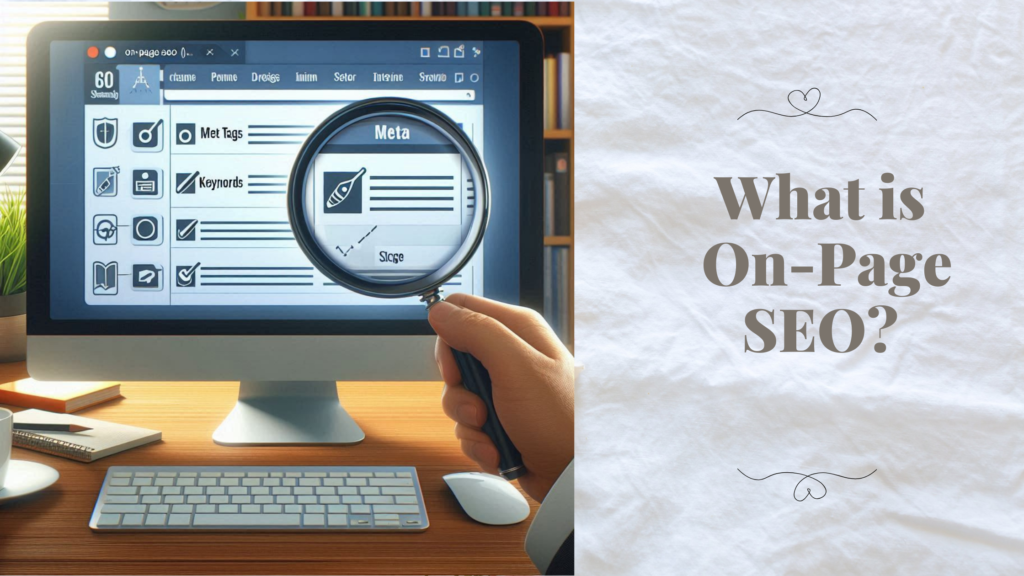On-page SEO, also known as on-site SEO, refers to the process of optimizing individual web pages to improve their search engine rankings and attract organic traffic. Unlike off-page SEO, which focuses on external signals like backlinks and social media, on-page SEO revolves around optimizing both the content and HTML source code of a page. The ultimate goal is to ensure that search engines like Google can easily understand what your page is about and rank it higher for relevant search queries.
Key Elements of On-Page SEO
1. Content Quality and Relevance:
The backbone of any on-page SEO strategy is high-quality, relevant content. Search engines prioritize websites that offer valuable information to users. Ensure that your content is original, insightful, and answers the queries users might have. Research the keywords your target audience is searching for and strategically incorporate them into your content without overstuffing.
Beyond keywords, the depth of content, including its structure, tone, and readability, plays a crucial role. Content that is easy to read and offers value is more likely to keep users engaged and lead to higher rankings.
2. Title Tags:
The title tag is one of the most critical elements of on-page SEO. This tag appears in the search engine results and informs both users and search engines about the page’s content. A well-optimized title tag should be concise, around 60 characters, and include your primary keyword naturally.
For example, instead of “Best SEO Tips” as a title tag, you could use “10 Best SEO Tips to Boost Your Website Traffic in 2024.” This approach not only includes the main keyword but also provides a sense of specificity and value.
3. Meta Descriptions:
While meta descriptions do not directly affect rankings, they influence click-through rates (CTR), which can impact your overall SEO. A meta description provides a brief summary of a web page and should be around 150-160 characters. Write it in a way that entices users to click on your page by emphasizing the value or benefits they’ll get by visiting.
Including the primary keyword naturally in the meta description is also helpful, as search engines tend to highlight these words in bold when they appear in a search result.
4. URL Structure:
A clean and concise URL structure is essential for on-page SEO. URLs should be easy to read, descriptive, and include the primary keyword.
For instance, instead of a URL like www.example.com/p123, it’s better to have something like www.example.com/best-seo-practices. This makes it easier for both users and search engines to understand the page’s topic at a glance.
5. Headings (H1, H2, H3):
Headings help break up your content, making it easier to read for users and helping search engines understand the hierarchy of information on a page. The H1 tag typically represents the main title of the page and should include the primary keyword.
Subsequent headings, such as H2 and H3, should be used to structure the content logically, allowing search engines to interpret the relationships between different sections of your content.
6. Keyword Optimization:
Effective keyword optimization is at the heart of on-page SEO. Keywords should be placed strategically throughout the content, including in the title, meta description, headings, and body text. However, avoid keyword stuffing, as this can lead to penalties from search engines. Instead, focus on maintaining a natural flow and using synonyms or related terms (LSI keywords) to support the primary keyword.
7. Internal Linking:
Internal linking refers to linking to other pages within your website. This helps users navigate your site and allows search engines to crawl and index your pages more efficiently. Internal links also pass authority from one page to another, which can improve the SEO of your entire site. When adding internal links, make sure to use descriptive anchor text that reflects the linked page’s content.
8. Image Optimization:
Images are an essential part of a web page, and optimizing them can improve both user experience and SEO. Use descriptive filenames and alt text for your images, incorporating relevant keywords where appropriate. This helps search engines understand the content of your images, which can improve your visibility in image search results.
9. Mobile Responsiveness:
In today’s mobile-first world, ensuring that your website is responsive is crucial for on-page SEO. Google uses mobile-first indexing, meaning it primarily considers the mobile version of your site when ranking pages. A mobile-friendly design not only boosts your SEO but also provides a better user experience, reducing bounce rates and increasing engagement.
10. Page Load Speed:
Page load speed is a critical ranking factor for SEO. A slow-loading page frustrates users and can lead to higher bounce rates. Tools like Google’s PageSpeed Insights can help identify issues that are slowing down your site, such as large image files or excessive JavaScript. Improving your site’s speed can enhance both SEO and user satisfaction.
Conclusion
On-page SEO is the foundation of a successful search engine optimization strategy. By focusing on the key elements like content quality, title tags, meta descriptions, and mobile responsiveness, you can enhance both your website’s visibility and user experience.
Remember, SEO is an ongoing process, and regular updates and optimizations are necessary to maintain and improve your search engine rankings over time.


Pingback: How can I improve my website's SEO ranking?